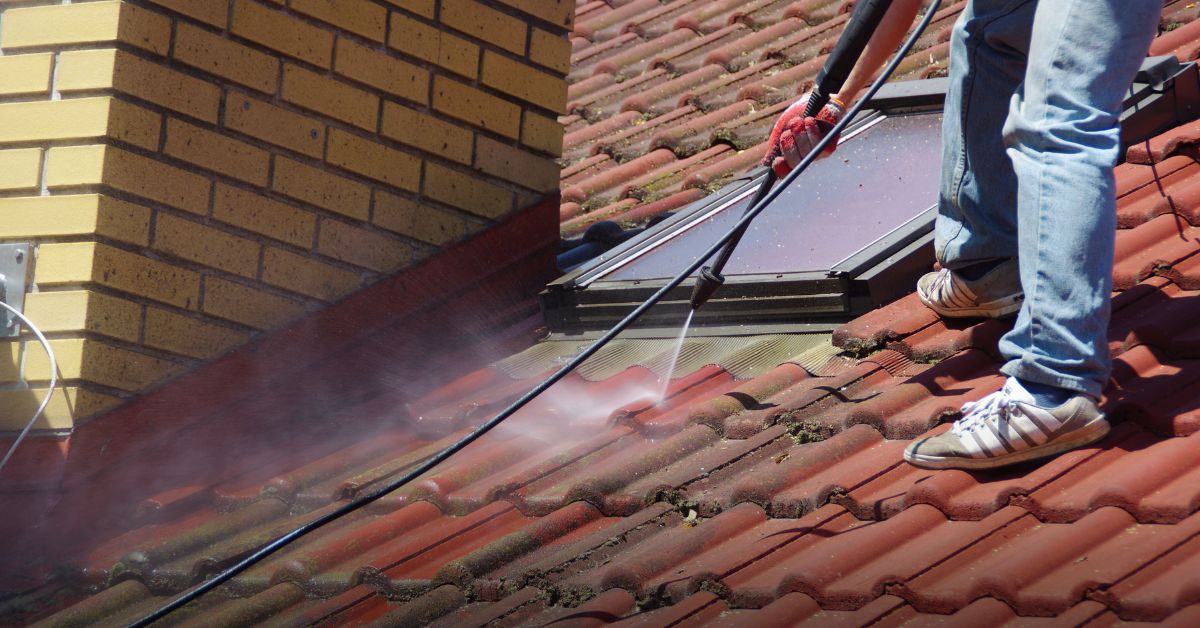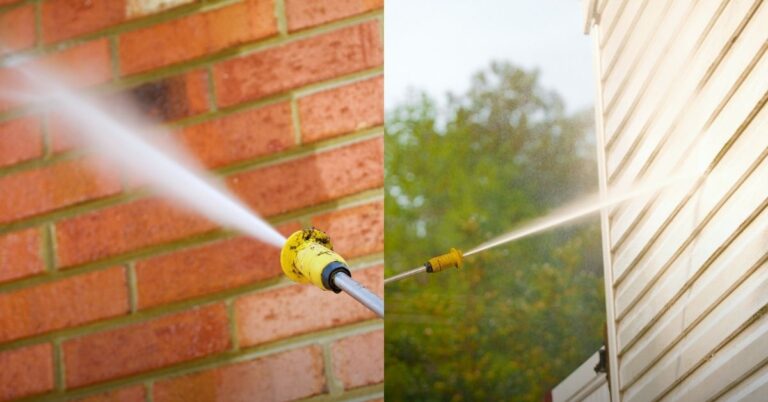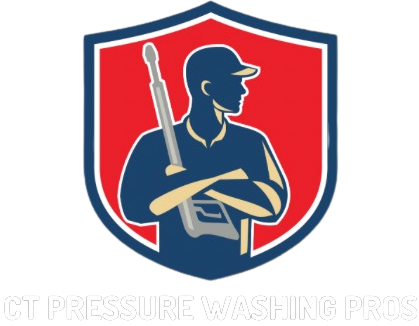Your roof is your home’s first line of defense, but over time, dirt, moss, and algae start taking over. What seems like a harmless stain can be a warning sign of deeper problems. Moss traps moisture, weakening shingles and leading to leaks. Algae create dark streaks that absorb heat, making your home hotter and increasing energy bills.
Ignoring it can cost you. A neglected roof won’t just look bad—it’ll wear out faster, forcing you into expensive repairs or even a full replacement. Regular cleaning keeps it strong, extends its lifespan, and saves you money in the long run.
But there’s more. A clean roof boosts curb appeal, making your home look fresh and well-maintained. Whether you plan to sell or just take pride in your home, a spotless roof makes a difference.
So, is cleaning worth it? Let’s dive into the pros and cons to help you decide.
Table of Contents
Pros of Roof Cleaning
A dirty roof isn’t just an eyesore—it’s a ticking time bomb for costly repairs. Moss, algae, and stains do more than make your home look old; they weaken shingles, trap moisture, and drive up energy bills. Let’s learn the key benefits of roof cleaning.
1. Extends the Lifespan of Your Roof
Your roof is constantly exposed to the elements. Over time, moss, algae, and lichen start growing, slowly breaking down shingles and weakening the structure. Moisture gets trapped, leading to rot, leaks, and costly damage. Cleaning your roof removes these threats, helping it last longer and saving you from expensive repairs.
2. Improves Curb Appeal and Home Value
A dirty roof makes even a well-kept home look neglected. Streaks, stains, and moss growth can give the impression of age and poor maintenance. A clean roof instantly refreshes your home’s look, making it more attractive to neighbors, guests, and potential buyers. If you’re planning to sell, a well-maintained roof can even add value by showing buyers they won’t need to replace it anytime soon.
3. Prevents Costly Repairs and Replacements
Roof damage doesn’t happen overnight—it builds up over time. Small patches of moss and dirt may not seem like a big deal, but they create the perfect environment for rot and deterioration. Regular cleaning stops problems before they start, keeping repair costs down and delaying the need for a full replacement.
4. Increases Energy Efficiency
Dark streaks on your roof aren’t just ugly—they absorb heat. That extra heat transfers into your home, making your air conditioner work harder and driving up your energy bills. A clean roof reflects more sunlight, keeping your home cooler and helping you save on electricity.
5. Eliminates Health Hazards
Mold and mildew love damp, shaded roofs, but they don’t always stay there. Spores can spread into your attic and ventilation system, affecting indoor air quality. This can trigger allergies and other respiratory issues, especially for those with asthma. Regular roof cleaning helps prevent this, keeping your home healthier and safer.
A clean roof does more than just look good—it protects your home, saves money, and even helps with energy efficiency. But is it always the right choice? Let’s look at some potential downsides before you decide.
Cons of Roof Cleaning
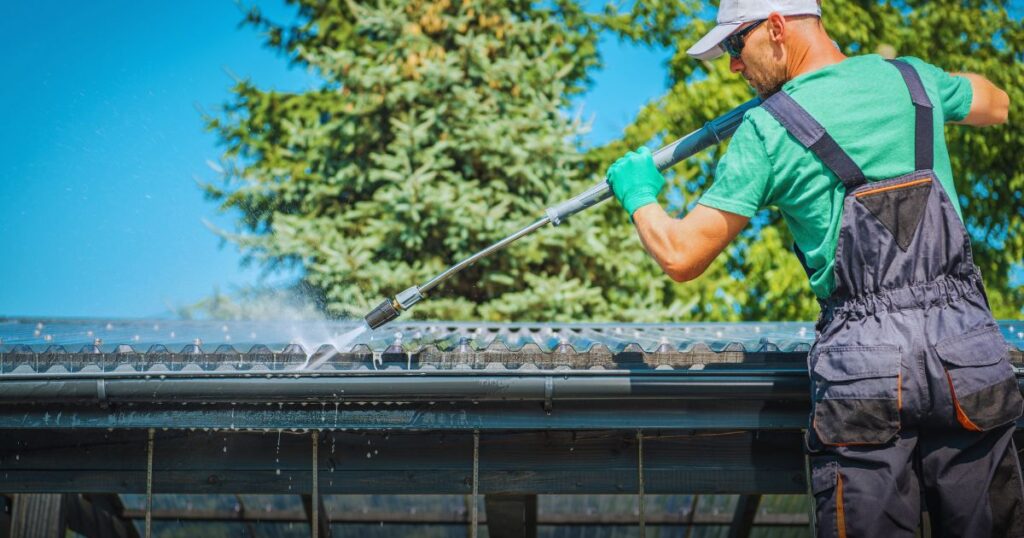
A clean roof has plenty of benefits, but it’s not always risk-free. If done incorrectly, it can cause damage, lead to ongoing maintenance costs, and even create safety or environmental concerns. Before making a decision, here are some drawbacks to consider.
1. Potential Roof Damage from Incorrect Cleaning Methods
Not all cleaning methods are safe. High-pressure washing can strip away the protective granules on shingles, making them more vulnerable to weather damage. Some chemicals can break down roofing materials, leading to cracks or premature aging. Choosing the wrong method can do more harm than good, shortening the lifespan of your roof instead of extending it.
2. Temporary Solution—Requires Regular Maintenance
Cleaning your roof doesn’t mean the problem is gone forever. Algae, moss, and debris will eventually return, especially in humid or shady areas. Some homeowners find themselves needing to clean their roofs every year or two, adding to long-term maintenance costs. Without preventive measures like zinc strips or roof coatings, it’s an ongoing battle.
3. Can Be Expensive
Hiring a professional to clean your roof can cost anywhere from a few hundred to over a thousand dollars, depending on the size and condition of your roof. While DIY methods seem cheaper, buying the right equipment and cleaning solutions still adds up. Plus, if mistakes are made, repairs can cost far more than the cleaning itself.
4. Safety Risks Involved
Climbing onto a roof is risky, even for professionals. Slippery surfaces, steep angles, and unpredictable footing make falls a real danger. Using chemicals also comes with risks—improper handling can cause skin irritation, breathing problems, or accidental exposure to pets and plants. For many homeowners, the safety concerns alone make hiring a professional the better option.
5. Environmental Concerns
Some roof cleaning chemicals can harm plants, pets, and nearby water sources. Runoff from certain treatments may seep into the soil, affecting landscaping or even local waterways. While eco-friendly options exist, they may not be as effective or require multiple applications, increasing costs and effort.
While roof cleaning has clear benefits, it’s not a one-size-fits-all solution. So, should you clean your roof or leave it alone? Let’s go over some best practices to help you make the right choice.
Best Practices for Roof Cleaning
Cleaning your roof the right way can extend its life, improve your home’s appearance, and prevent unnecessary damage. But not all cleaning methods are equal, and DIY attempts can sometimes cause more harm than good. Here’s how to ensure your roof stays clean and protected while avoiding costly mistakes.
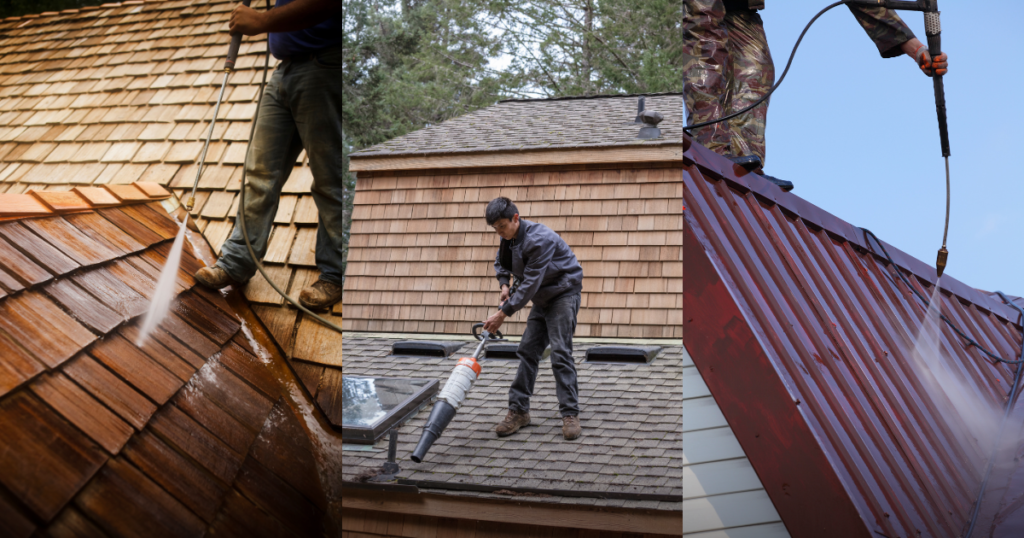
1. Choosing the Right Cleaning Method
Not every roof should be cleaned the same way. The two most common methods are soft washing and pressure washing, and choosing the wrong one can damage your roof.
- Soft Washing: This method uses low-pressure water combined with cleaning solutions to break down algae, moss, and grime. It’s the safest and most effective option for asphalt shingles, tile, and other delicate materials.
- Pressure Washing: While effective on some surfaces, high-pressure washing can strip away the protective layer on shingles and force water underneath them, leading to leaks. It’s rarely recommended for traditional residential roofs.
For homeowners concerned about chemicals, eco-friendly cleaning solutions are available. Professional roof cleaners use specialized formulas that remove algae and moss without harming your landscaping or posing risks to pets and children.
2. Hiring Professionals vs. DIY Roof Cleaning
Roof cleaning might seem like a simple job, but it comes with real risks. Many homeowners underestimate how slippery and dangerous a roof can be, leading to accidents that aren’t worth the savings of a DIY job.
When to hire a professional:
- If your roof has heavy moss, black streaks, or years of buildup.
- If your roof is steep or hard to access safely.
- If you want a long-lasting clean without the risk of damage.
Why professional cleaning is the better choice:
- Experts know the safest and most effective cleaning methods for each roof type.
- Professional services use industrial-grade solutions that keep roofs clean for longer.
- Hiring a professional eliminates safety risks and ensures the job is done right the first time.
While some homeowners attempt DIY cleaning, it often requires buying special equipment, climbing a dangerous slope, and working with chemicals that need to be handled carefully. A professional service takes the stress, risk, and guesswork out of the process.
3. Preventive Measures to Reduce Roof Contaminants
Once your roof is clean, keeping it that way requires preventive maintenance. Without proper care, moss, algae, and dirt will return quickly. Here’s how to slow down buildup and protect your roof:
- Install zinc or copper strips along the ridge of your roof. These metals naturally prevent algae and moss growth when rainwater washes over them.
- Regular inspections can catch small problems before they turn into major damage. A quick check twice a year helps you spot early signs of buildup or wear.
- Clean your gutters to prevent debris from piling up and creating moisture problems that encourage mold and algae growth.
A well-maintained roof lasts longer, looks better, and saves you money on repairs. Hiring a professional ensures the job is done safely and effectively while reducing the need for frequent cleanings. If you’re ready to refresh your roof, let the experts handle it the right way!
Conclusion: Is Roof Cleaning Worth It for Your Home?
Roof cleaning isn’t just about looks—it’s about protection, efficiency, and long-term savings. A well-maintained roof prevents damage, keeps energy bills in check, and enhances your home’s value. But like any home maintenance task, it comes with risks, from potential damage to ongoing costs.
So, what’s the best approach? If your roof has noticeable algae, moss, or stains, cleaning it sooner rather than later can prevent expensive repairs. But how you clean it matters. Using the wrong method or attempting a risky DIY job can lead to more harm than good. That’s why professional roof cleaning is the safest and most effective option. Experts know what works, use the right techniques, and help keep your roof cleaner for longer.
In the end, a clean roof is an investment in your home’s future. Whether you want to extend its lifespan, improve curb appeal, or avoid unnecessary repairs, keeping it in top shape is always a smart decision. If you’re ready for a safer, more effective solution, let a professional handle the job and give your roof the care it deserves.

